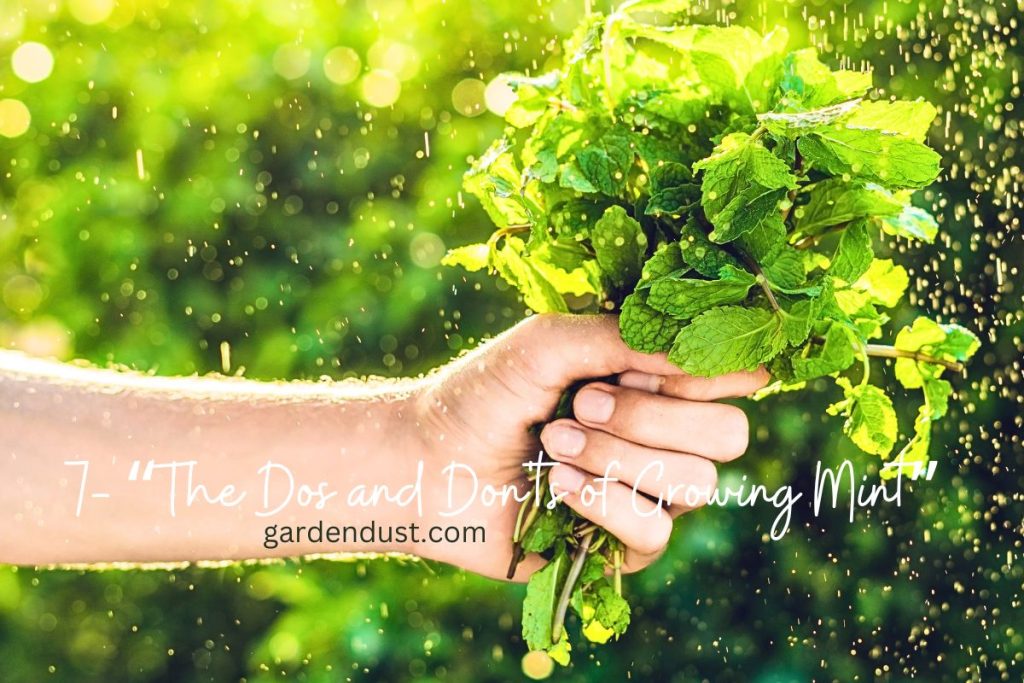Mint, with its refreshing aroma and versatile culinary uses, is a favorite herb for many gardeners. Whether you want to add a fresh twist to your dishes or simply enjoy the soothing fragrance in your garden, growing mint can be a rewarding experience. However, mint can be a bit of a wild child in your garden if not managed properly. In this guide, we’ll explore the dos and don’ts of growing mint to ensure a thriving herb garden and prevent mint from taking over. Let’s see…
The Dos:
1. Choose the Right Location
Selecting the right location is crucial for mint’s growth. Here are some factors to consider:
- Partial Sun: Mint prefers partial sun, meaning it should receive about 4-6 hours of sunlight daily. It can tolerate some shade, especially in hot climates.
- Well-Drained Soil: Ensure that the soil is well-drained to prevent waterlogged roots. Mint thrives in slightly acidic to neutral soil with a pH of 6.0 to 7.0.
2. Use Containers or Borders
Mint has a reputation for spreading rapidly through underground runners. To keep it contained, consider planting it in containers or designated garden borders. This will prevent it from invading other parts of your garden.
3. Water Adequately
Mint enjoys consistently moist soil but not waterlogged conditions. Water your mint plants regularly, ensuring the soil remains consistently damp. Avoid letting the soil dry out completely.
4. Prune Regularly
Regular pruning is essential to encourage bushy growth and prevent leggy, straggly mint plants. Pinch off the tips of the stems to promote branching and keep the plant compact.
5. Fertilize Sparingly
Mint doesn’t require heavy feeding. A light application of balanced fertilizer in the spring should be sufficient. Avoid excessive nitrogen, as it can lead to excessive foliage growth at the expense of flavor.
6. Harvest Correctly
Harvesting mint is one of the pleasures of growing it. To maximize flavor and promote healthy growth, pick the leaves regularly. Harvest in the morning when the essential oils are most concentrated. Snip the leaves from the top of the plant to encourage new growth from the bottom.
7. Rotate Planting Locations
If you plan to grow mint year after year, rotate its planting location. This reduces the risk of soil-borne diseases and helps maintain healthy mint plants.
The Don’ts:
1. Don’t Plant in Full Sun
Mint prefers partial sun to partial shade. Avoid planting it in full sun, as this can cause it to wilt and become stressed.
2. Don’t Overwater
While mint likes moist soil, it doesn’t tolerate waterlogged conditions. Overwatering can lead to root rot and other fungal diseases. Be sure to let the soil surface dry slightly between watering sessions.
3. Don’t Neglect Containers
If you choose to grow mint in containers, don’t forget to check the pots regularly for signs of overcrowding or root binding. Repot your mint every couple of years to ensure healthy growth.
4. Don’t Plant Near Other Herbs
Mint’s aggressive growth can quickly overtake neighboring herbs in your garden. Avoid planting mint directly in the ground next to other herbs unless you’re prepared for it to dominate the area.
5. Don’t Skip Pruning
Neglecting to prune your mint plants can lead to leggy, unattractive growth. Frequent pruning is necessary to maintain the plant’s shape and encourage fresh growth.
6. Don’t Let It Flower Too Much
Mint plants will produce flowers if left unchecked. While the flowers can be attractive, they signal the end of the plant’s prime growing season, and the leaves may become less flavorful. To encourage robust leaf growth, pinch off the flower buds as they appear.
7. Don’t Use Chemical Pesticides
Mint is generally hardy and not prone to many pests or diseases. Avoid using chemical pesticides in your herb garden, as they can harm beneficial insects and contaminate your mint leaves. Instead, opt for organic pest control methods if necessary.
Common Mint Varieties-
There are several mint varieties to choose from, each with its unique flavor and characteristics. Here are a few popular ones:
- Spearmint (Mentha spicata):
Flavor: Mild, sweet, and slightly peppery.
Uses: Ideal for mojitos, teas, salads, and desserts.
- Peppermint (Mentha x piperita):
Flavor: Strong, cool, and minty.
Uses: Perfect for making mint tea, adding to chocolate dishes, and garnishing cocktails.
- Chocolate Mint (Mentha x piperita ‘Chocolate’):
Flavor: Minty with a hint of chocolate.
Uses: Great for desserts, especially those with chocolate.
- Orange Mint (Mentha x piperita ‘Citrus’):
Flavor: Zesty and citrusy.
Uses: Adds a refreshing twist to beverages, salads, and fruit dishes.
Growing mint can be a delightful addition to your garden and culinary adventures if you follow these dos and don’ts. Remember to choose the right location, keep it contained, and provide proper care in terms of watering, pruning, and harvesting. By following these guidelines, you can enjoy a bountiful harvest of flavorful mint leaves while preventing your herb garden from turning into a mint jungle. So, roll up your sleeves, plant some mint, and savor the rewards of this versatile and aromatic herb. Happy Gardening….






